We have all the time in the world today, because this is, after all, The Time Travel Blogathon.
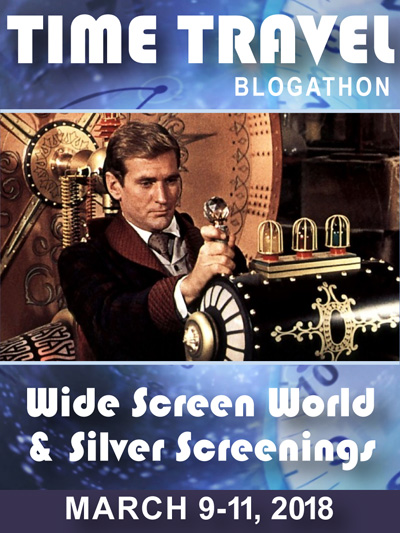
The event has been set up by the Silver Screenings blog, together with the Wide Screen World blog () – so be sure to point your browser in that direction, and enjoy the wide variety of interesting posts on the subject of time travel.
And then find a minute to come back here, because we are going to take a ride on The Time Machine.
The classic one, the one imagined by H.G. Wells, and created by George Pal in 1960.
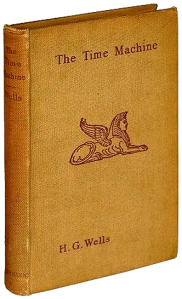 The Time Machine is recognized as a landmark work in the development of science fiction. H.G. Wells published his story in 1895 and as much of his works, it has a central political and social concern that informs the narrative.
The Time Machine is recognized as a landmark work in the development of science fiction. H.G. Wells published his story in 1895 and as much of his works, it has a central political and social concern that informs the narrative.
The unnamed Time Traveler of the story travels to the far future in his machine, looking for the time in which man will have left behind his violent and warlike nature to build an ideal society. What he finds is not what he expected.
In the year 802,701, humanity has split into two distinct species, the Eloi and the Morlocks. The Eloi live a time of leisure in a sort of eternal present, without a culture or a sense of history, and showing very little human spirit or emotion, while the Morlocks live underground and mind the machinery that keeps the whole system going. The only drawback, the Morlocks eat the Eloi.
Wells’ picture of the evolution of the Victorian class system is merciless1.
Incidentally, the name Eloi is derived from Elohim, meaning “lesser gods”, while Morlocks may be a variant of mollock (that used to mean “miner”), or a Scottish term for rubbish, or a reference to the Morlachs, a people that was considered particularly primitive and brutish.
And anyone interested in the original The Time Machine can find a digital copy in the archives of the Project Gutenberg.
The reason why we gave so much space to the Wells novella is that the 1960 adaptation directed by George Pal sticks very close to the original thanks to the screenplay by David Duncan. Most of the film is narrated by the Time Traveler, just like the original story, and the film is therefore mostly a big flashback. The major licenses the screenplay takes are with the timeline – and the movie uses the real wars of 1917 and 1940 to provide two dramatic stops along the way for time traveler Rod Taylor. And of course London gets bombed in 1965 by “atomic satellites” – because it was 1960 after all, and the effects of the Russian Sputnik on the collective unconscious were still felt.
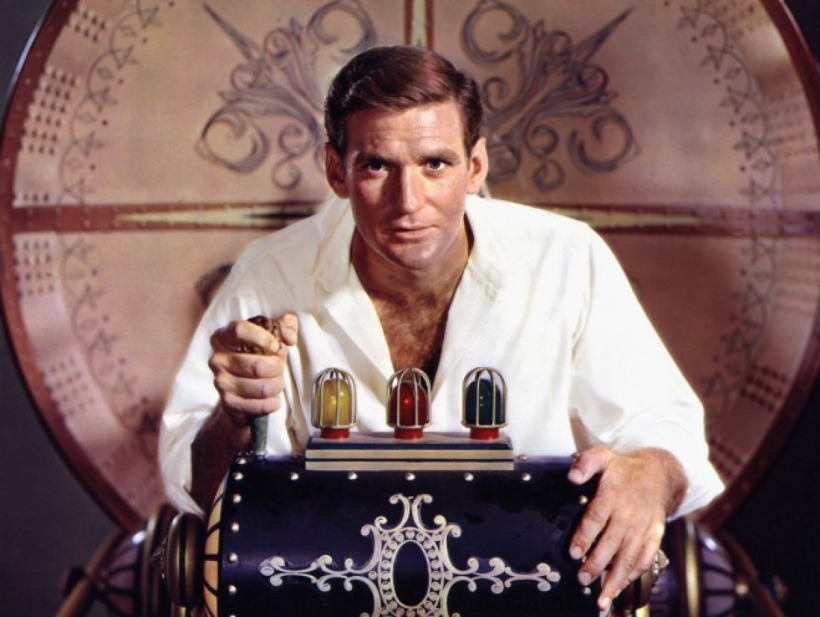
Rod Taylor was not the original choice by George Pal, that would have preferred David Niven or Charles James Mason 2 for the part. Taylor was finally selected because he was better suited for the action scenes in the second half of the movie. The Time Traveler’s name – that is not given in the Wells story – is here given as “George”, a tribute to both George Pal and Herbert George Wells. George’s love interest, Weena, is played by Yvette Mimieux, that turned 18 during filming, and is absolutely wonderful as a childish member of the Eloi race. And she is absolutely stunning.

The Eloi, incidentally, all uniformly young, blond and vacuous, are sort of a dress rehearsal for the coming “youth culture” – the boys even sport haircuts that would later be popularized by the Beatles.
Their society is showed in all its chilly superficiality when George asks to be shown some books, and he’s led to a forgotten bookshelf filled with volumes that turn to dust when touched.
“Yes, these books tell me all I need to know about you.”
But this is a George Pal movie, and the actors are just as important as the effects.
The movie looks like a million dollars – which is more or less how much it cost. The low budget made it necessary to film in Culver City instead of London. There’s a lot of matte paintings providing futuristic landscapes, and a very ingenious use of a rather limited number of sets.
The most iconic of the matte paintings is probably the one depicting the Black Sphinx of the Morlocks.
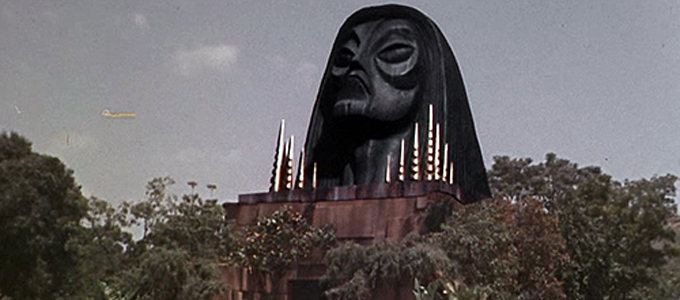
Time-lapse photography is used to show the passage of time from the traveler’s point of view, and the changing clothes on a shop-window mannequin provide a nice visual gag. There is also a scene in which a branch flowers and then bears fruits in a few seconds – and in this case the time-lapse effect was simulated, and the scene is actually a painting photographed during its development.
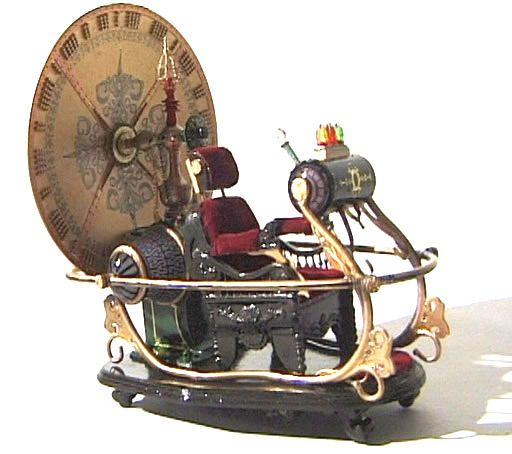
But the true beauty (apart from Yvette Mimieux) is, of course, the Time Machine itself – the design based on a sled, with the brass fittings and the big rotating disk and the cut-crystal driving lever. Together with the Nautilus from 20.000 Leagues Under the Sea, the George Pal Time Machine, all brass and red velvet, with its Art Noveau decor is one of the original inspirations for today’s steampunk aesthetics.
There are 365 rivets in the rotating disk, that was supposed to turn clockwise when the machine advanced through time, and counterclockwise when traveling backwards. The mechanism malfunctioned and the double sense of rotation was never used.
Famously, the Time Machine carries a plaque that reads “Built by H. George Wells.”

In the end, George defeats the Morlocks (in a brawl that looks like the blueprint for all the future Captain Kirk fist-fights in Star Trek) and brings a certain resurgence of human dignity in the Eloi – which is more than the original Time Traveler did in the Wells story. Also, George gets the girl, which is much more than what his anonymous counterpart got from Wells.
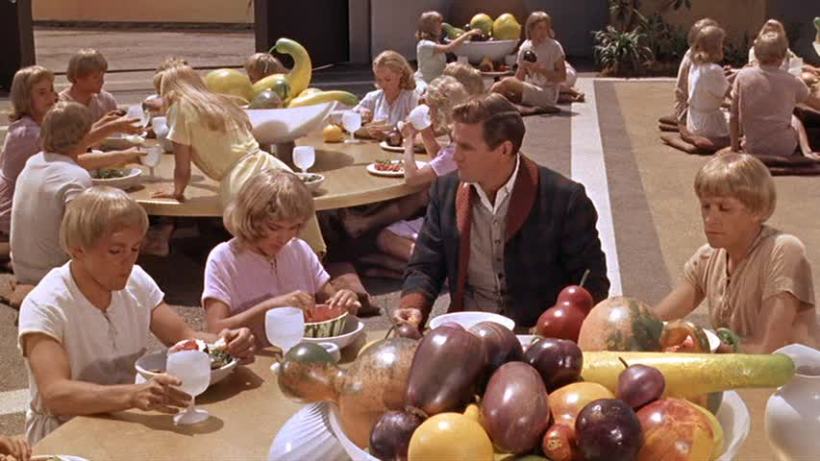
But before the happy ending – hinted at and not shown – George still finds the time to get back to London and tell about his adventure to his four friends (Alan Young, Sebastian Cabot, Tom Hellmore and Whit Bissell), three of whom act as jerks and do not believe him, not even when he shows them an “impossible flower” he brought back from the future.
Understandably let down by his friends, George goes back to the future (aha!), and to rebuild the human civilization, he brings along three books. The film closes with his only loyal friend asking George’s housekeeper what three books she’d carry into the future. The question remains unanswered, and is still today a great, if somewhat geeky, conversation topic.
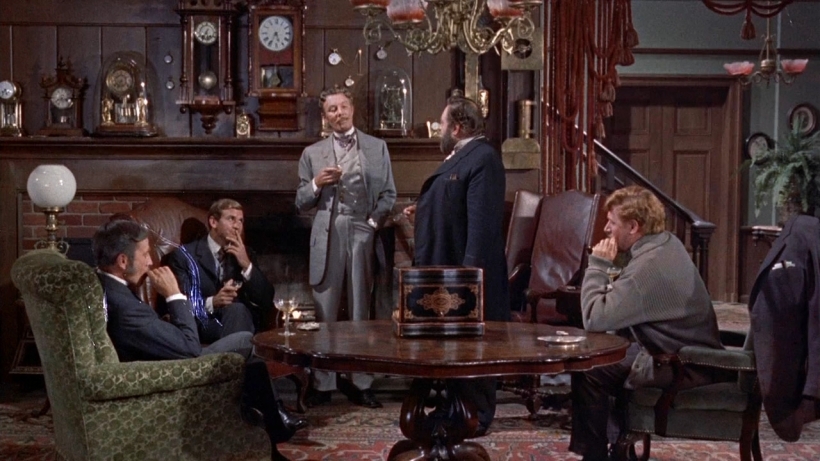
In 1961, The Time Machine won an Oscar for the special effects, and was nominated for a Hugo Award (but the award went to The Twilight Zone. Interestingly enough – or maybe not – another movie was nominated for the 1961 Hugo: The Village of the Damned, that features all-blond, emotionless children (like the Eloi) with glowing eyes (like the Morlocks).
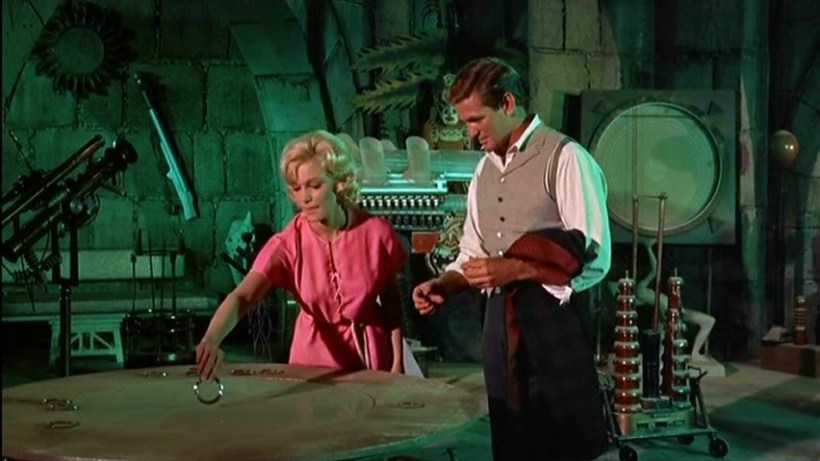
Today it is a common sport to hunt for continuity errors and other nits to be picked with the movie, but the fact remains that The Time Machine is an intelligent, fun and yet thought-provoking movie for viewers of all ages. I first saw it when I was maybe eight years old, I always watch it when I chance upon it, and I re-watched it before I wrote this post. It has aged wonderfully, it is visually stunning, filled with nice touches and memorable scenes (such as George’s first appearance, his first experiment with the miniature Machine, and the haunting scene with the Talking Rings) and basically quite good. Nitpickers be damned, check it out – you might be surprised.
- In a paroxysm of vanity, I could point out that the first seeds of a species divergence and split in Eloi and Morlocks are part of the background in my own Hope & Glory, that is a world based, also, on Victorian scientific romances. ↩
-
where did Charles Mason spring from?
From some unholy cross between James Mason and Charles Manson?
Or is it because I am writing a story featuring a character called Charles and modeled on David Niven, so that’s the first name that comes to my mind when Niven is mentioned, and poor James Mason was an innocent victim of my confused mind?
This is a mystery we will never solve, I guess. ↩

Pingback: Announcing the Time Travel Blogathon – Silver Screenings
9 March 2018 at 15:23
The Time Machine has become one of my comfort food films. I watch it with the nostalgia associated with some movies of my youth, but still with the awe at the adaptation. I am always moved by the scenes between Taylor and Young, and the plaque in the park dedicated to George.
LikeLike
9 March 2018 at 15:57
Yes, it’s a movie that it’s good to comeback to.
I first saw it as a kid, and it made an indelible impression.
LikeLike
9 March 2018 at 15:51
George Pal’s creativity in special effects is also proved by 1956 The War of the Worlds. Just a quick question: what do you think about the 2004 movie based on the same book, which had -if I remember correctly – a bitter ending?
LikeLike
9 March 2018 at 16:00
I watched the 2004 movie and was mostly unimpressed – it tries to play cynical, but in the end it is only soulless.
LikeLike
9 March 2018 at 15:51
1953, sorry!!! 😀
LikeLiked by 1 person
10 March 2018 at 00:40
Last fall, I bought a volume of Wells stories, which includes THE TIME MACHINE. I started reading it, but haven’t finished it yet. Too preoccupied with other stuff.
You wrote the name “Charles Mason.” Did you mean James Mason? None of the actors named Charles Mason that I found on IMDB seemed appropriate.
LikeLike
10 March 2018 at 01:36
I am absolutely stupid… of course I meant James Mason, and I will correct the text.
Charles Mason is some kind of horrific subconscious collision between James Mason and Charles Manson, I guess… 😀
LikeLiked by 1 person
10 March 2018 at 03:50
Hi 😊
I like your perspective about this movie. For me, this will always be a Classic. It is a great story in an enjoyable movie.
LikeLike
11 March 2018 at 13:44
Thank you!
And yes, it is a great movie.
LikeLiked by 1 person
10 March 2018 at 11:33
I am reading The Time Machine with an eye on writing a review of both for a post in September to celebrate H. G. Wells’ birthday. (going to do three or four books vs. movies then.) Great review.
LikeLike
11 March 2018 at 13:45
Thank you!
LikeLike
10 March 2018 at 14:58
The time travel machine itself is a thing of beauty. It’s the most glamorous time travel prop in film history, if you ask me.
This film seems to hit all the right notes. It’s philosophical and a terrific adventure, but it’s also creepy when it needs to be.
So glad you chose “The Time Machine” for the blogathon. I was hoping someone would cover it, and I’m happy it was you.
LikeLike
11 March 2018 at 13:46
Thank you.
It was good to go back in time (ah!) and watch the movie again.
LikeLiked by 1 person
10 March 2018 at 16:29
I love the idea of that book-question, just wish I could answer it.
All my favorite books are subversive, probably only as good as they are in relation to normal books.
LikeLike
11 March 2018 at 13:46
I see your point.
I do not have an answer to the three-book problem myself.
My titles change depending on the day and the mood.
LikeLiked by 1 person
14 March 2018 at 21:26
I love the Pal film and the book (don’t much like the later film though even if it does star one of my favourite actors, Guy Pearce). I must confess to feeling a certain amount of sympathy with the Morlocks though – hard at work keeping everything going while the Eloi lounge around looking pretty. Probably because it reminds me of a few jobs I’ve had in the past 🙂
LikeLike
15 March 2018 at 00:59
Yes, the Morlocks suffered from a lot of bad press. And in more way than one, the real monsters are the Eloi.
LikeLike
16 March 2018 at 00:21
Awesome review, David! I enjoyed The Time Machine, and your review made me want to revisit the film sometime. It is a clever adaptation and a very entertaining movie at the same time – a perfect example of what the 1960s had in store for us in th cinematic world.
Cheers!
LikeLike
16 March 2018 at 11:36
Thank you!
LikeLike